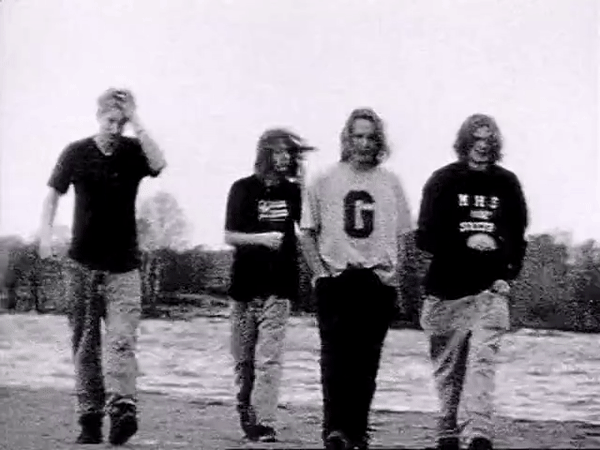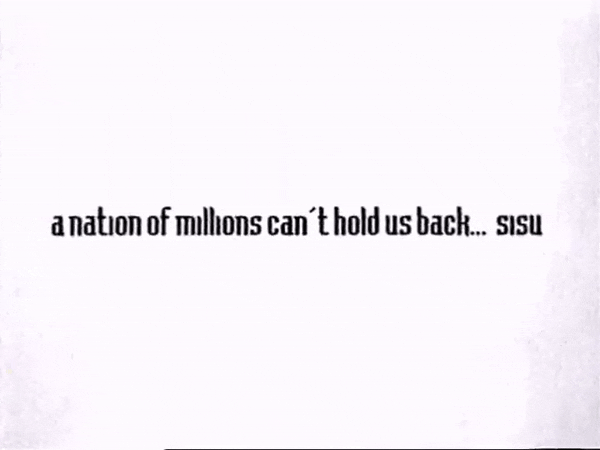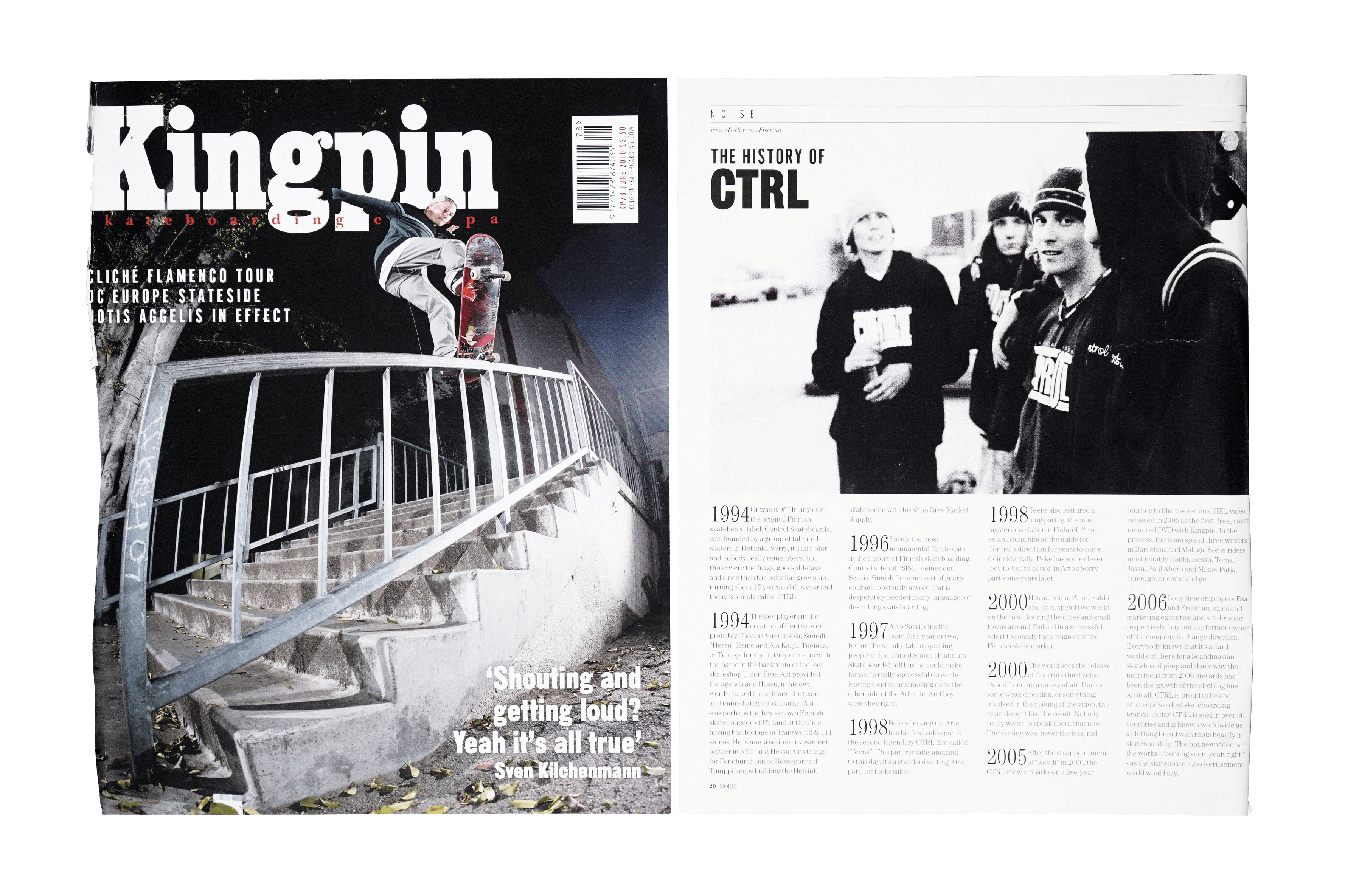CTRL: An Interview with Helsinki-based Designer Tomi Freeman
A Conversation with Eileen Skyers


Tomi Freeman is the designer behind the brand CTRL(pronounced Control), which is one of the oldest European skateboarding brands. I met him over email, accidentally, after a shot-in-the-dark attempt at reaching out to the brand’s email address to figure out their Finland store location and hours. During my first trip to Helsinki, I would learn that he was a local presence. “This man’s a legend!” someone exclaimed at Putte’s Bar, where he’d introduced me to some of his buddies over cool, bitter beverages. Generous, humble, and downright pleasant to be around, Freeman was as enigmatic and casual as the decades-old skate and streetwear brand that he’s now fostered for years.

Like most culture-makers and disruptors, he hadn’t calculated a formal ideology around the brand. He sort of fell into design haphazardly, after putting together some boards, t-shirts, and hoodies in the mid-90s under the umbrella of the shop Union 5. Their skateboarding film SISU debuted in 1996, and it is still among the most monumental films in the world of Scandinavian skateboarding. "Sisu" translates loosely to a sort of relentless perseverance against all odds—something that defines much of Finnish culture, and subsequently, the brand CTRL. Now, after more than two decades, CTRL has somehow remained decidedly underground—an earnest, long-standing alternative to some of today’s cheapened, default gatekeepers of internet hype. More importantly, though, CTRL seems to embody a real sense of place. It is grounded within the quiet reverie and sturdiness of its Scandinavian underpinnings. I sat down with Freeman over coffee and a Zoom grid recently to discuss the origins of Finnish streetwear, ask about what Helsinki has been like in lockdown, and to try to parse, once and for all, the true meaning of the word sisu.

Eileen: Can you tell me a little bit about the history of CTRL, like when it started, who was involved in the early days and where it's at now?
Freeman: So it started in '95. Some say it was '94, but I think it was '95. It started as a group of skaters in Helsinki, and there was this store called Union Five. So Union Five was the only store in Helsinki that stocked skate brands, like Girl, Chocolate—all the hottest labels at that time. Back then, the skate scene was already super strong in Finland. So they were sponsoring a lot of kids. But the owners—funnily enough—all the owners were from this small town called Jarvenpaa, which is like 30 kilometers from Helsinki. So Jarvenpaa ends up playing an important role in the history of Helsinki, skateboarding, and fashion. Because it was so expensive to have a skate team, and sponsorships with all the US labels, the crew around Union Five was super strong. It was kind of natural that CTRL evolved. Maybe it was first like a t-shirt, and then “let's do some boards,” and then the owners, they were like, “okay, we could actually make this a proper label.”
Eileen: So that you could sponsor skaters yourselves?
Freeman: Yeah. So we had our main guys, and set up a real team. I owe everything to the skaters, because they were such a strong, super charismatic team. You could say they were some of the coolest guys in Helsinki. When we released the first movie Sisu (1996) it got a lot of exposure, not just in Finland, but around the world—especially in Europe—only because the skateboarding was so good. The level was super good.
Eileen: Everyone was just super talented.
Freeman: So I think it became an important part in the history of European skateboarding, because CTRL was one of the first European skateboard labels. That’s when people started realizing that you could actually have your own teams and skateboard labels in Europe.
Eileen: It was all in the US at that time?
Freeman: It was just California. Even New York hadn't really started. Supreme was super small for a long time. No matter where you were from in the US, if you went pro you kind of had to move to California. But slowly the European scene developed, and the UK was playing a big role on that.
Eileen: So it all got started naturally with skateboards?
Freeman: Yeah. We were doing the hard goods—wheels, boards, and so on. Then we started doing t-shirts, and then people wanted more, and they sold out super fast. So we could introduce other types of clothing, and like actually set up a clothing line, which happened super organically. When I did my first graphics for CTRL, I wasn't the owner. In the beginning Union Five was the store that owned it. So when I did my first designs, I pretty much didn't even know how to use Photoshop or whatever.



Eileen: Can you tell me why the first skate film was called Sisu?
Freeman: It's really hard to translate, but it kind of means you're going through, like...no matter what, you're fucking going through that shit. It's kind of the word that describes the Finnish stubbornness or in a way like...
Eileen: Perseverance?
Freeman: Yeah. I don’t think there’s an English word. That might be close.
Eileen: So with the growth of the clothing line, you started doing different kinds of t-shirts, button downs, tote bags and things? Maybe venturing into a little bit more women's wear?
Freeman: Yeah, it wasn't really structured at that time though. We noticed that there were a lot of stores asking for our stuff around Europe, pretty much all over the place. Especially the core skateboarding stores. We set up a booth at this trade show called ISPO, and for the booth I just designed some weird graphics. I wasn't really following what was happening in the states, or in skateboarding. So I think that made a huge difference because a lot of people were expecting like, “yeah, okay, they must be copying what's happening in California.” And that was the feedback we always got, was that we were just...different.
Eileen: Could you talk to me about some of the collaborations you’ve done over the years?
Freeman: Yeah, let's say from 2000 to 2015 or something there was a lot of stuff. We did a lot with Japanese labels, because Japan was really good for us. For some reason they really liked CTRL. Our distributors were super cool. They were kind of like our buddies speaking the same language and they really believed in the label. We collaborated with some stores that were selling our stuff, and with Stadium in Tokyo…
I mean, how did you get to know about CTRL?
Eileen: That's a good question. I feel like I found something on Instagram at some point, and I was just like, “Oh, this is really sick. This is coming out of Helsinki.”
Freeman: Yeah, because I think you were...
Eileen: I was kind of looking at different spaces. Right? And then I found that party that you threw at the Beyond venue.
Freeman: Right.



Kingpin Skateboarding, 2010. History of CTRL
Eileen: How did you get started with graphic design?
Freeman: When I was still studying graphic design, I moved to Barcelona to work for a year. Back then Lodown magazine was like the coolest thing I could think of. It was like super, super cool. It's still ongoing, which is pretty good for a print magazine nowadays. I sent them my portfolio and then they replied like, “Whoa, that looks dope. How about doing a double spread?”
Eileen: Wow. Now, that kind of thing just happens in comments or DMs—that feeling of like, “Oh, this brand noticed what I'm doing,” Back then it was an email exchange.
Freeman: Yeah, exactly. Nowadays I hate email, email kind of used to be fun. Now, it's more like...getting an invoice through your door or something.
Eileen: What are you guys up to now? Or what's next? I know you sent me some of the sewing work that you've been doing. I know that might be separate from CTRL.
Freeman: Yeah, it's not CTRL. I got this old workhorse called Bernina from my grandmother, like this old sewing machine. And then I have old CTRL fabrics leftovers. So I just thought I'd make some pillows, nothing to do with anything—lockdown hobbies.
Eileen: How has Helsinki been during lockdown, or over the past year?
Freeman: Well, the spring had some restrictions, and people would not go out that much. Summer was pretty much normal, but now it's getting worse. Like much worse than...I mean way worse than ever. So we'll probably be...well, the bar is closed this Monday. I'm working on a logo for a new bar opening in Helsinki for a friend of mine. And I think that he chose the worst time ever to open a bar.
Eileen: Oh, probably.
Freeman: They opened it for one day, and then lockdown came.
Eileen: Wow. What’s the bar called?
Freeman: Limbo.
